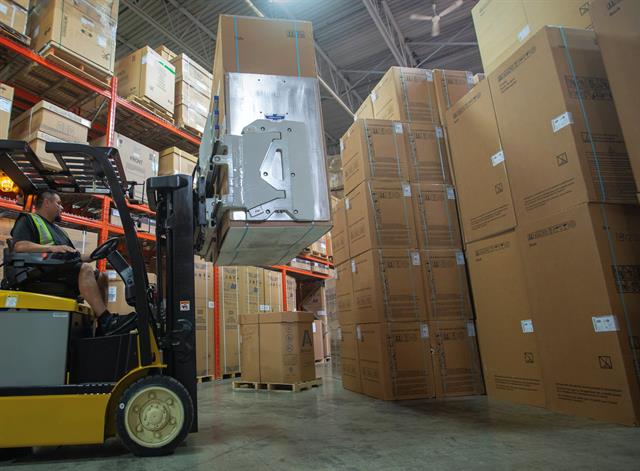 Storage areas don't generate profit. PHOTO: CASCADE |
FORKLIFTACTION EXCLUSIVEThe COVID-19 crisis is creating new opportunities for materials handling, especially as manufacturers are forced to adopt stringent health and social distancing regulations.
Combilift managing director Martin McVicar tells
Forkliftaction News that clients are finding they need more space on their production floor to accommodate social distancing, and one of the simplest solutions is to free up space used for raw materials or finished goods.
The number of enquiries at the Irish forklift maker has doubled in May as demand for warehouse space increases, he says.
At the same time, there's a strong realisation that "storage areas don't generate profit - the production area generates the revenue - regardless of industry or products".
Combilift is responding to the increased demand with enhanced warehouse consultancy services and has even moved to "virtual site inspections" to assess client needs and draft suitable solutions.
Meanwhile, Frank Heptner, senior director - sales and realisation intralogistics solutions at German materials handling giant Linde, is also seeing increased interest from clients looking to reconfigure storage and warehouse spaces within the existing footprint.
"One option is to expand production areas. Another option is to customise workflows; for example, reduce storage areas to gain work space, or use automation to reduce physical contacts," he says. "We have spoken to customers about such possibilities lately; however, this is just the beginning. From what I can already see, I predict that the set-up of production and logistics facilities will radically change in the future. New concepts will evolve, especially driven by automation."
Like Combilift, Linde is not always able to visit client sites because of restrictions at plants, so the company is using "digital environments to offer solutions to our customers".
"However, before signing a new contract, we need to be on site at least once (preferably, multiple times) to make sure the offered solution can be realised as planned," he explains.
Even though interest is extremely strong, Combilift will have no difficulty meeting a surge in demand, says Martin McVicar. "Combilift supply chains continue to be very strong. With no major supplier issues on the horizon and with the volume of buffer components we carry in stock, we are confident we can meet ongoing demand."
According to Heptner, "Linde Material Handling is preparing to meet increased demands. Even for certain automated solutions, we have already been able to stock AGV solutions; for other solutions, we'd have to check availability and decide case by case," he says.
The storage shortages caused by COVID-19 are not limited to manufacturers. Similar challenges for the logistics sector are highlighted in a recent white paper by warehouse space strategist Bis Henderson Space.
The report,
Warehouse Space: A New Strategy For A New Reality, highlights an apparent lack of vision on planning future space needs. "Amid the frenzied acquisition of warehouse space, it is hard to discern much implementation of deep, pre-existing, strategy," says report author Steve Purvis, operations director at Bis Henderson Space.
"Indications are that businesses may well be considering a reversal of thinking on running lean supply chains with low inventory cover," says Purvis. "This is likely to lead to increased levels of inventory being held over the long-term, with a subsequent upsurge in demand for warehouse space."